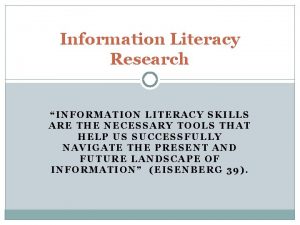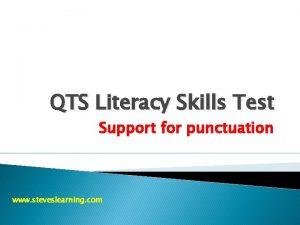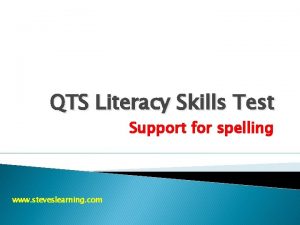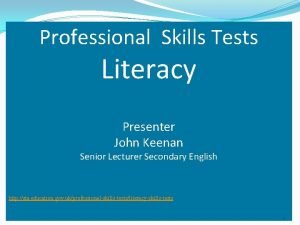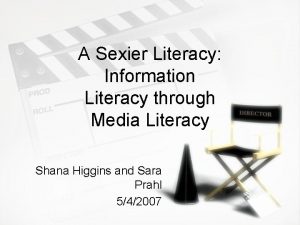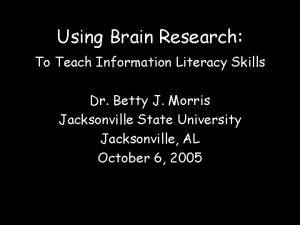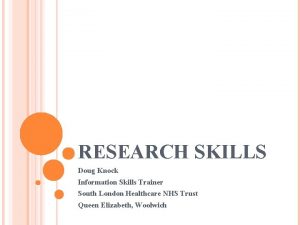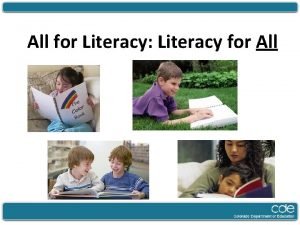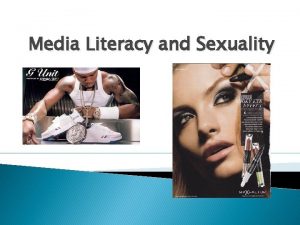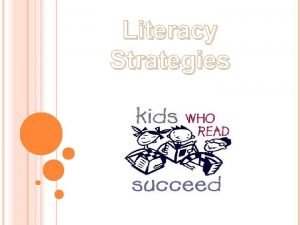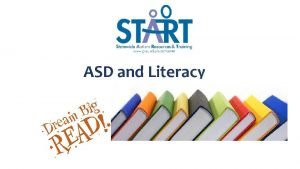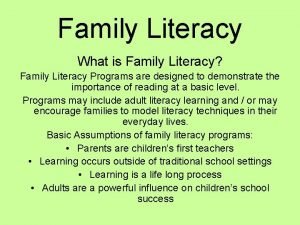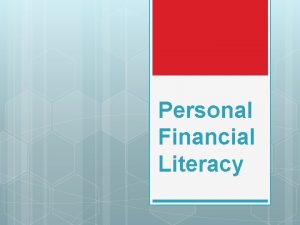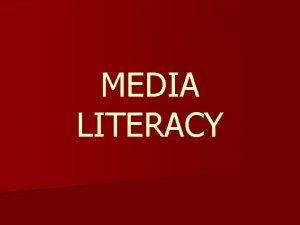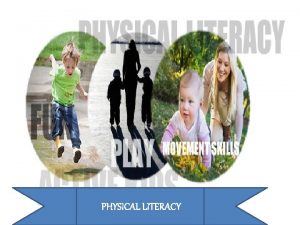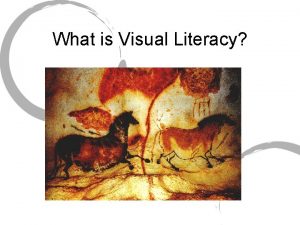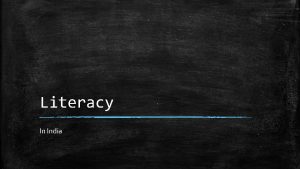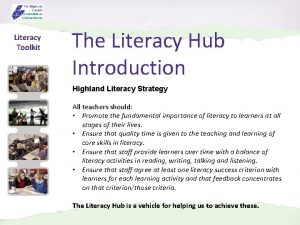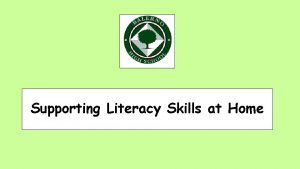Information Literacy Research INFORMATION LITERACY SKILLS ARE THE



















- Slides: 19

Information Literacy Research “INFORMATION LITERACY SKILLS ARE THE NECESSARY TOOLS THAT HELP US SUCCESSFULLY NAVIGATE THE PRESENT AND FUTURE LANDSCAPE OF INFORMATION” (EISENBERG 39).

Why Big 6? “DATA COLLECTED FROM THOUSANDS OF STUDENTS SHOWED THAT STUDENTS WHO WERE TAUGHT INFORMATIVE NONFICTION USING THE BIG 6 APPROACH WITH A COMBINATION OF ANALYTICAL, CREATIVE, AND PRACTICAL ACTIVITIES, OUTPERFORMED STUDENTS WHO WERE TAUGHT TWO ALTERNATIVE APPROACHES. ” — LINDA JARVIN, PH. D. , ASSOCIATE DIRECTOR, PACE CENTER, YALE UNIVERSITY

Metacognitive Scaffold: A Case Study -Student Profile -Topic -Collaboration -Metacognitive Scaffolds -Data Collection -Results and Findings -Implications OR “What does it all mean? ”

What is the Big 6? a systematic approach to information problem-solving six broad skill areas necessary for successful information problem-solving a complete library and information skill curriculum

Major Components 1. Task Definition 2. Information Seeking Strategies 3. Location and Access 4. Use of Information 5. Synthesis 6. Evaluation

We Need the Big 6 Aligns with 3 different types of technology and information literacy standards Easily integrates into all curriculum Promotes collaboration between classroom teachers and the LMS Teaches students about new technologies

We Need the Big 6 Can be differentiated to meet the learning needs of all students Is a flexible, workable model Helps students become information literate citizens who are able to solve problems both in and out of the school setting

Alignments with Standards Each step of the Big 6 model correlates with each of the following four sets of standards: National Educational Technology Standards (NETS) Information and Communications Technology (ICT) Literacy Proficiencies Standards for the 21 st-Century Learner Academic content standards (Murray 39)

Curriculum Integration Fits all grade levels Fits all curricular areas Enhances student understanding of both subject material and information literacy standards

Promotes Collaboration Curriculum Mapping Planning integrated units Implementation of lessons and exercises Assessment of Final Projects

Exposure to Technology should be taught as part of the problem solving process. There a wide variety of computer skills as well as new Internet and software technologies that directly align with the steps of the Big 6 model. “At each stage, technology can boost the information problem-solving process. ” (Eisenberg 22)

Differentiation by students’… Interests Readiness Learning Profile

Flexible Many problem-solving models are systematic and rigid Big 6 is also a systematic model, however it “does not assume or require that people go through the process in a fixed, linear way. ” (Eisenberg 21)

Problem Solving Citizens This model is designed for students to use in situations in the classroom as well as out in the world. They should be able to use the steps of the Big 6 (sometimes without even realizing it) in their “school, personal, and work applications, as well as all content areas. ” (Eisenberg 21)

Benefits of Using the Big 6™ Our students will: Learn transferable planning and organizing skills they will be able to apply for a lifetime

Implementation Plan Professional Development Teacher involvement District wide usage Create user friendly reference materials

Works Cited “Big 6. ” Information & Technology Skills for Student Achievement. 5 Feb. 2009. <http: //www. Big 6. com> Buzzeo, Toni. Collaboration to Meet Standards: Teacher Librarian Partnerships for 7 -12. Worthington: Linworth Publishing, 2002. Eisenberg, Michael B, Carrie A. Lowe and Katherine L. Spitzer. Information Literacy: Essential Skills for the Information Age. 2 nd ed. Westport , Connecticut: Libraries Unlimited, 2004. Eisenberg, Michael B. “Implementing Information Skills: Lessons Learned from the Big 6 Approach to Information Problem. Solving. ” School Libraries in Canada 22. 4 (2003): 20 -3. Library Lit & Inf Full Text. H. W. Wilson. North Hall Library, Mansfield, PA. 3 June 2009 http: //vnweb. hwwilsonweb. com/.

Works Cited Continued Harada, Vilet H. , and Joan M. Yoshina. Inquiry Learning through Librarian-Teacher Partnerships. Worthington: Linworth, 2004. Jansen, Barbara A. “Differentiating Instruction in the Primary Grades with the Big 6. ” Library Media Connection Jan/Feb (2009): 32 -3. EBSCOhost. North Hall Library, Mansfield, PA. 3 June 2009 http: //web. ebscohost. com. Kuhithau, Carol Collier. “The Process of Learning from Information. ” School Libraries Worldwide Jan. 1995: 1 -12. Library Literature and Information Science Full Text. H. W. Wilson. North Hall Library, Mansfield, PA. 3 June 2009 http: //hwwilsonweb. com/.

Works Cited Continued Murray, Janet. “Looking at ICT Literacy Standards: Through the Big 6 Lens. ” Library Media Connection. 26. 7 (2008): 38 -42. Library Lit & Inf Full Text. H. W. Wilson. North Hall Library, Mansfield, PA. 3 June 2009 http: //vnweb. hwwilsonweb. com. Kuhithau, Carol Collier. “The Process of Learning from Information. ” School Libraries Worldwide Jan. 1995: 1 -12. Library Literature and Information Science Full Text. H. W. Wilson. North Hall Library, Mansfield, PA. 3 June 2009 http: //hwwilsonweb. com/. Wolf, Sara. "The Big Six Information Skills As a Metacognitive Scaffold: A Case Study {computer file}. " School Library Media Research 4 June 2009. http: //www. ala. org/Content/Navigation. Menu/AASL/ Publications_and_Journals/School_Library_Media_ Research/Contents 1/Volume_6_(2003)/Big_Six_Info rmation_Skills. htm
 Antigentest åre
Antigentest åre Media literacy and information literacy similarities
Media literacy and information literacy similarities Berlos model of communication
Berlos model of communication People and media
People and media Big six information literacy skills
Big six information literacy skills Cyber literacy and digital literacy
Cyber literacy and digital literacy Pgce skills test
Pgce skills test Print awareness checklist
Print awareness checklist Literacy skills test spelling
Literacy skills test spelling Literacy professional skills test
Literacy professional skills test Intra personal skills
Intra personal skills Soft skills definition
Soft skills definition Ontario skills passport essential skills
Ontario skills passport essential skills Hát kết hợp bộ gõ cơ thể
Hát kết hợp bộ gõ cơ thể Ng-html
Ng-html Bổ thể
Bổ thể Tỉ lệ cơ thể trẻ em
Tỉ lệ cơ thể trẻ em Chó sói
Chó sói Tư thế worm breton là gì
Tư thế worm breton là gì Alleluia hat len nguoi oi
Alleluia hat len nguoi oi




